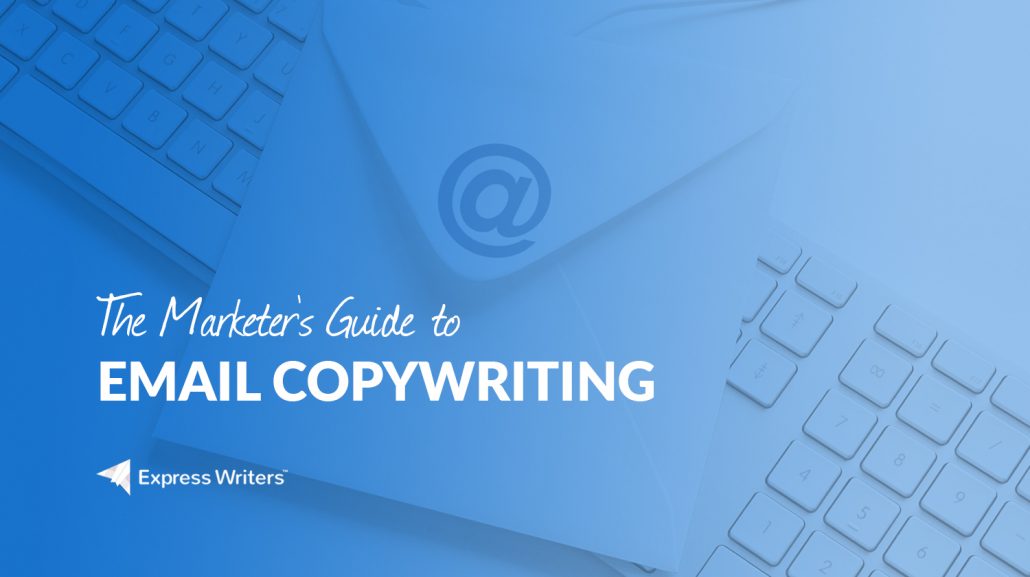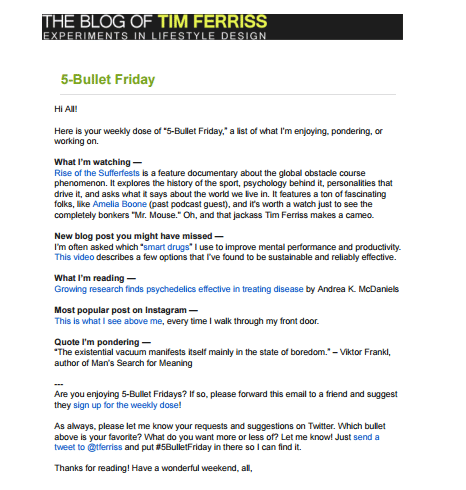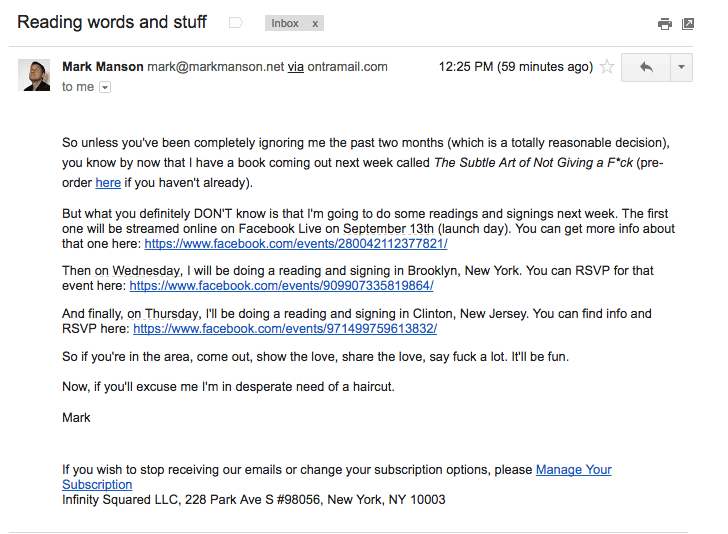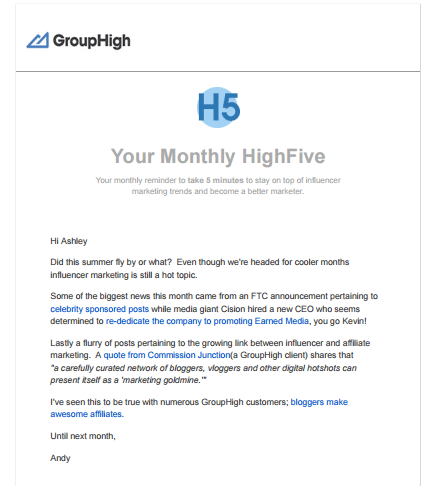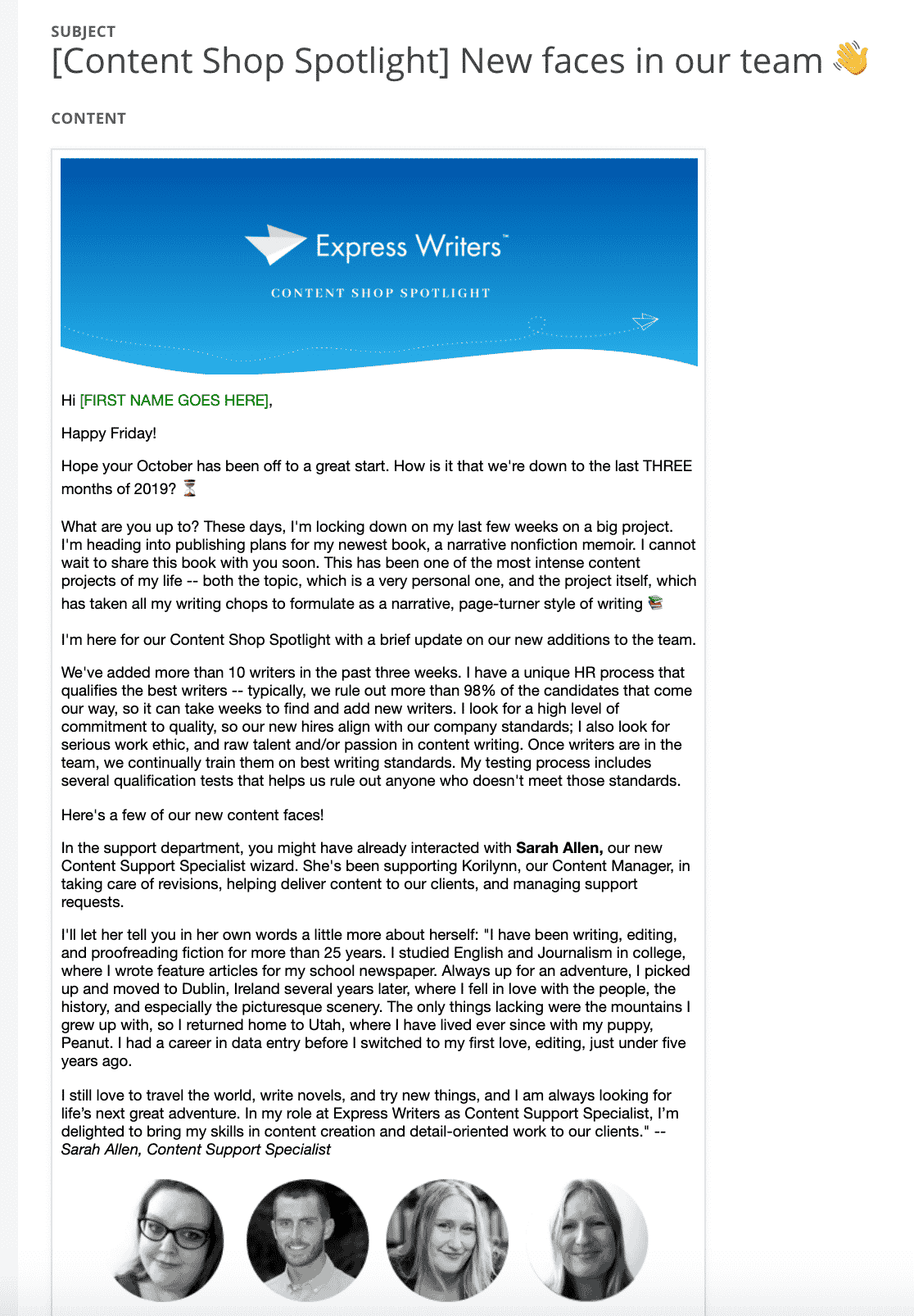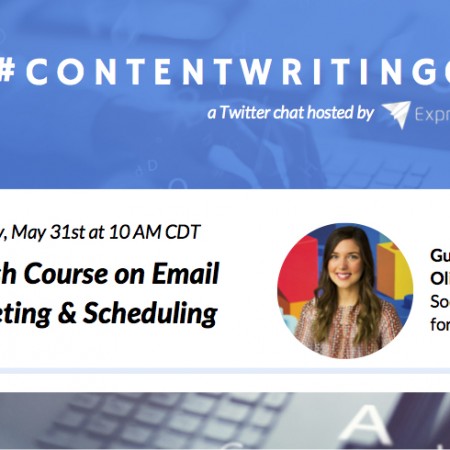
#ContentWritingChat May 31 2016 Recap: A Crash Course on Email Marketing & Scheduling
Did you miss #ContentWritingChat this week? Before you hit “send” on your next email newsletter, get caught up with our recap and brush up on your email marketing skills.
#ContentWritingChat May 31 2016 Recap: A Crash Course on Email Marketing & Scheduling
Join us for #ContentWritingChat Tuesday, May 31st at 10 AM CDT with @oliviadello and the @AWeber team! pic.twitter.com/X2R0TVAlkJ
— Express Writers (@ExpWriters) May 24, 2016
This week, Olivia Dello Buono was our guest host. Olivia is the Social Media Specialist for AWeber. She shared her tips and tricks for writing amazing emails. You won’t want to miss them!
Q1: How important is it for a business to have an email list? What benefits does it provide?
Should every business have an email list? And how important is email marketing? To find out the benefits of having an email list for your business, check out these answers:
A1. It’s crucial. There’s so much noise on the web, and email provides that 1:1 connection with consumers. #ContentWritingChat
— Olivia Dello Buono (@oliviadello) May 31, 2016
A1. (cont.) Email might not be as shiny, sexy (or free) as social, but it comes with an ROI of $38 per every $1 spent. #ContentWritingChat
— Olivia Dello Buono (@oliviadello) May 31, 2016
As Olivia pointed out, there’s a lot of noise happening online these days. It can be hard to break through all of that and stand out! Your email list provides a good way to push through the noise and connect with your subscribers. And who could argue with that ROI?
A1. Email marketing can get you crazy high ROI. But more importantly, it’s the best way to connect with people! #contentwritingchat
— Kristen Dunleavy (@KristenWritesIt) May 31, 2016
Kristen is a Content Marketing Specialist at AWeber, so it’s no surprise she knows the impact email marketing can have! Not only will your email list get you a high ROI, but it’s also a great way to connect with your audience.
A1: If they’re actually going to USE it, very important 🙂 Benefits=keeping in front of clients #ContentWritingChat https://t.co/ScTFIuidDM
— ThinkSEM (@ThinkSEM) May 31, 2016
As Sarah from ThinkSEM said, an email list is graet for keeping you in front of your clients. Your email list allows you to stay top of mind for them when they see you pop up in their inbox. What’s the key thing to remember? If you’re going to create an email list, you need to actually USE IT.
A1) #1 benefit is having a list reduces time and effort in communications #contentwritingchat
— Scott Johnson (@iScottJohnson) May 31, 2016
Scott knows an email list provides a simple, yet effective, way for you to keep in touch with people. You can easily send a mass email out to your list and reach thousands of inboxes.
A1 #Email list is your personal #Social network to connect, engage, convert them into loyal cust #ContentWritingChat https://t.co/Pem4DfmiFd
— Varun Kumar (@varunkr842) May 31, 2016
Varun views an email list as your own personal social media network. That’s a great way to look at it right? It allows you to connect and engage with your audience, while giving you the chance to convert them into loyal customers. That’s a huge plus!
@writingchat A1: Lists are huge! Once you get them built you can start segmenting, targeting, and testing #ContentWritingChat
— Jacob Rouser (@J_Rouser) May 31, 2016
As Jacob said, once you get your list going, you can segment, target, and test to create the right emails for your audience. This is essential if you want to make sure you’re giving your audience the exact content they’re looking for.
A1 Vital. Otherwise you risk seeing your web traffic slip thru your hands. Huge for communication, building rapport etc #ContentWritingChat
— Julia McCoy (@JuliaEMcCoy) May 31, 2016
Our CEO, Julia, knows email lists are crucial. Use your list to communicate with your audience and build rapport, which are essential if you want to succeed in business.
Q2: How do you get people to sign-up for your email list?
Once you’ve started your list, it’s time to get those subscribers! How do you do it? Start implementing these tips:
A2. I’m a firm believer in incentives. Offering valuable content in exchange for an email address always wins. #ContentWritingChat
— Olivia Dello Buono (@oliviadello) May 31, 2016
A2. (cont.) Need incentive ideas? Bookmark this for later: https://t.co/joNIQg0QNl #ContentWritingChat
— Olivia Dello Buono (@oliviadello) May 31, 2016
The inbox has become a sacred place for many. Not everyone is quick to hand over their email address, so you better give them something good in return. Olivia recommends providing an incentive for signing up. If you can give your audience high-value content in exchange for their email, you’re golden.
A2: By providing valuable content, like webinars, guides, email courses, etc. #contentwritingchat
— Liz Willits (@lizwillits) May 31, 2016
Focus on adding value if you want to snag those subscribers! Liz (also a Content Marketing Specialist at AWeber) suggests offering a webinar, a guide, or even an email course to increase sign-ups.
#ContentWritingChat A2: Give them something of value that solves their problems, but be original – no 1 needs 10 eBooks on basics of #SMM
— New Jupiter Media (@NewJupiterMedia) May 31, 2016
Get creative with your opt-in incentive! There are so many things you can offer to people who subscribe to your list. Don’t be afraid to think outside the box and test a few things to see what converts the best.
Q3: What are some tips for writing great email subject lines?
When it comes to email subject lines, you want to make sure they’re great in order to encourage people to open. How do you do that? Check out these tips:
A3. Short, sweet and to the point. Your subject line should be relevant, while leaving a little to the imagination. #ContentWritingChat
— Olivia Dello Buono (@oliviadello) May 31, 2016
Olivia said to keep it short, sweet, and to the point. Keep your subject lines relevant and let people know exactly what they’ll find if they open it.
A3: Consistent voice, brief (but not too brief), and the occasional emoji doesn’t hurt! #ContentWritingChat
— Jane Clauss (@JaneClauss) May 31, 2016
Jane recommends keeping your subject titles consistent with the voice you typically write in. You might want to consider adding an emoji, too! It’s an easy way to help your email stand out in a crowded inbox.
A3. Also a huge fan of emojis in the subject line ✌??? #ContentWritingChat
— Olivia Dello Buono (@oliviadello) May 31, 2016
It looks like Olivia is a fan of emojis as well! Have you used them in your email marketing?
A3 @writingchat Play with your clients/audience curiosity. Also use a question as a subject line #ContentWritingChat https://t.co/fDl05RfIBw
— Alberto Gómez (@alberMoire) May 31, 2016
Alberto said to play with your audience’s curiosity. Use your subject line to intrigue them and make them want to open your email. A question is always a nice way to do this.
A3) Keep it simple. Allude to something they want to know more about. #contentwritingchat
— Kyle Murray (@TheKyleMurray) May 31, 2016
What’s Kyle’s advice? Keep it simple! Use your subject line to refer to something your audience wants to know more about. It helps if you have a good understanding of exactly who your audience is, which is why you really need to get to know them.
A3. Keep it precise. Data suggests that 40-50 characters works best for an ideal email subject line. #ContentWritingChat
— Cheryl Joy (@CherylJoy2) May 31, 2016
Cheryl is also a fan of keeping it on the shorter side. She reports that data suggests 40-50 characters works best.
@writingchat A3: Test, test, and test. Don’t be afraid to change it up and see what happens #ContentWritingChat
— Jacob Rouser (@J_Rouser) May 31, 2016
Jacob knows testing is key. What works for your audience might not work for someone else’s audience. Don’t be afraid to change it up and test different subject lines to see which ones get the most opens. A/B split testing is extremely helpful for this.
A3) Don’t think you have to be perfect. Use variations so you can test several and use the best. #ContentWritingChat
— Jeff Reno(e) (@Renoe) May 31, 2016
Great advice from Jenn: don’t think you have to be perfect. As she said, testing is important to see what works the best in the end.
A3b) Put yourself in the shoes of your recipients–Would you open the e-mail? #contentwritingchat
— Scott Johnson (@iScottJohnson) May 31, 2016
Great answer, Scott! Before you hit that send button, ask yourself if you would open the email with your chosen subject line. If the answer is no, odds are your subscribers won’t open it either.
A3: NEVER mislead your subscribers with your subject lines. They don’t want to be tricked into opening the email. #ContentWritingChat
— Rachel (@redheadrachel) May 31, 2016
One final thing to keep in mind: never mislead your subscribers. Don’t title your email subject something that’s unrelated to the content of your email. It’s tricking your subscribers. They won’t stick around long if you keep that up.
Q4: What kind of content should you send to your email subscribers?
You’ve got the subscribers, but what should you send them? Here’s what some participants from Tuesday’s chat had to say:
A4. Depends on your goal. But always make sure the content you send is aligned with what you promised subscribers. #ContentWritingChat
— Olivia Dello Buono (@oliviadello) May 31, 2016
Olivia said to keep in mind the goals you have for your email list. Make sure you’re delivering exactly what you promised your subscribers when they signed up.
A4. Send your best evergreen blog content. Use Google Analytics to decide which posts to share: https://t.co/FdjOZNjyzl #contentwritingchat
— Kristen Dunleavy (@KristenWritesIt) May 31, 2016
Kristen recommends sending some of your best evergreen content from your blog. The great thing about evergreen content is that it never gets outdated. It’s always relevant to your audience. Repurpose your best blog posts by turning them into emails.
.@ExpWriters #ContentWritingChat A4. Content that’s engaging, highly relevant, and rewarding. The reward could be a learning, or giveaway.
— Pratik Mohapatra (@mohapatrapratik) May 31, 2016
Pratik said to send content that’s engaging, highly relevant, and rewarding. Great answer!
A4: The kind of content they want to consume, of course. “Know thy audience,” people. #ContentWritingChat https://t.co/E3Fc13zjFv
— ThinkSEM (@ThinkSEM) May 31, 2016
To put it simply, you need to know your audience. Your emails should contain the type of content your audience is looking for. Give them what they want consistently and they’ll be happy to stick around. Spot on, Sarah!
A4: I recently asked subscribers what they want and got back responses, working on those now! #ContentWritingChat https://t.co/GBARAf80oI
— Badal Nyalang (@JasonNyalang) May 31, 2016
If you’re struggling to figure out what your audience wants, all you have to do is ask. They’re the best ones to tell you what they’d like to see in your emails. Create a survey, send it to them, and watch the responses roll in. Just make sure you act on those responses when you receive them.
A4) What did you promise them when they signed up? That’s one box you may not want to think too far outside of. #ContentWritingChat
— Jeff Reno(e) (@Renoe) May 31, 2016
As Jenn said, make sure you deliver on whatever it was you promised to your audience when they subscribed. If you send unrelated content, you’ll be sure to see a lot of unsubscribes.
A4) Content should be compatible: with the audience, with their needs, with their email systems! #ContentWritingChat https://t.co/OULaTlJCwf
— Jeremy Bond (@JeremyDBond) May 31, 2016
Jeremy said to make sure your email content is compatible with your audience, their needs, and their email systems. That’s key!
A4: Content that answers their biggest questions. #contentwritingchat
— Liz Willits (@lizwillits) May 31, 2016
Not sure what to send your subscribers? Answer their biggest questions with your content for a successful email marketing strategy.
A4 #Content depends on your TA preferences and where are they in customer journey map #ContentWritingChat https://t.co/0ZAs7EmDdu
— Varun Kumar (@varunkr842) May 31, 2016
Another thing to consider is how far along a subscriber is on their customer journey. For example, if someone just joined your list, it’s not a good time to pitch your latest product. Keep that in mind when sending out your emails.
A4 It’s a privilege to be invited to their inbox. Give them interesting, valuable content. #ContentWritingChat https://t.co/uapPZ7a5o9
— Erika Heald (@SFerika) May 31, 2016
As Erika said, it’s a privilege to have access to someone’s inbox in this way. Make sure you’re giving your subscribers amazing content to give them a reason to stick around.
Q5: When are the best times to send an email? How often should you send them?
Before you send out your next email blast, you might want to consider the date and time on which you’re sending it and how often you’re emailing subscribers. Take a look at these tips from Tuesday’s chat:
A5. This is a FAQ. There is no best time to send – it goes back to what your subscribers respond to. Test, test, test. #ContentWritingChat
— Olivia Dello Buono (@oliviadello) May 31, 2016
A5. Totally depends on your audience, so testing different days/times is key, #contentwritingchat
— Kristen Dunleavy (@KristenWritesIt) May 31, 2016
As our AWeber friends said, it really depends on your audience. Run some tests to see which dates/times perform best for your audience. What works for your subscribers might not work for someone else’s subscribers.
A5. Depends on the industry and ur audience. Test to see what time works for U. Data suggests Monday & Friday work best. #ContentWritingChat
— Epictions (@epictions) May 31, 2016
Are you noticing a pattern yet? Test, test, test! Some data suggests Monday and Friday are great days for sending emails, yet some tests might say otherwise. Figure out what works for your unique audience.
A5 Depends on TA & industry, talking to your customers – engage, keep them in the loop. Let them enjoy emails received ? #ContentWritingChat
— Zala Bricelj (@ZalkaB) May 31, 2016
You should always consider your target audience and the industry you’re writing for. Great answer, Zala!
A5. Consider your readers’ feelings. If you’re sending an email on Monday, make it lighthearted and fun. Mondays… #contentwritingchat
— Liz Willits (@lizwillits) May 31, 2016
A helpful tip from Liz: consider the feelings of your audience. A lighthearted, fun email on a Monday might help them beat the workday blues.
A5 I’ve found the times to send have varied. For frequency, let the subscriber set preference. #ContentWritingChat https://t.co/kfKPXWT60Q
— Erika Heald (@SFerika) May 31, 2016
If you want to give your subscribers some more control, allow them to select how often they’d like to receive emails from you. You can also let them choose email topics they’re most interested in.
@ExpWriters A5 1-2 per week +/- depending on business and clientele needs #ContentWritingChat https://t.co/trgnonX8T6
— Sir Leprechaunrabbit (@leprchaunrabbit) May 31, 2016
One or two emails per week is definitely a good goal to have. You want to stay relevant to your subscribers without overwhelming them. Consider their needs when creating email content.
A5) What are you selling? Breakfast message is irrelevant afterward unless you’re after Hobbits #contentwritingchat pic.twitter.com/MhHo8VVoba
— Jeff Reno(e) (@Renoe) May 31, 2016
You mean everyone doesn’t have second breakfast? As Jenn pointed out, consider what you’re selling when deciding when to send an email.
Q6: What tools can we use to start/grow an email list?
If you’re looking for some new tools to use in your email marketing, look no further! We have a round-up of some awesome tools you have to try:
A6. You’ll need an ESP (like @AWeber) with tools and functionality like autoresponders, signup forms, etc. #ContentWritingChat
— Olivia Dello Buono (@oliviadello) May 31, 2016
Of course, you may want to check out AWeber as your email service provider!
A6. @Leadpages is a great tool for creating sign up forms, landing pages & more fast. #contentwritingchat
— Kristen Dunleavy (@KristenWritesIt) May 31, 2016
As Kristen said, LeadPages is great for creating sign-up forms, landing pages, and more.
A6) Subscribing box at the end of each post and Exit opt-in pop ups #contentwritingchat
— Scott Johnson (@iScottJohnson) May 31, 2016
Scott recommends having a sign-up box below each of your blog posts and a pop-up that shows when someone tries to leave your website. Don’t be afraid to try a few different locations, pop-ups, etc. to see what converts the best for you.
.@ExpWriters #ContentWritingChat A6. Pop-ups (one on scrolling 50% and another on exit intent) and in-content subscribe field work best.
— Pratik Mohapatra (@mohapatrapratik) May 31, 2016
Pratik also recommends using a pop-up. Another great option is to have your pop-up show after someone has scrolled halfway down the page. It’s less intrusive than a pop-up that shows immediately upon arriving to your site.
A6 A landing/opt in page on #Blog or website, #Leadgen tools on #Socialmedia like #Twitter card #ContentWritingChat https://t.co/BwlrYOXlkf
— Varun Kumar (@varunkr842) May 31, 2016
Varun suggests using a lead generation tool on social media such as Twitter Cards. It’s a great way to promote your email list to get a boost in subscribers.
Q7: What are the best practices for maintaining a healthy email list?
If you want to keep your email list healthy and succeed at email marketing, here’s what you need to do:
A7. List hygiene is really important and often overlooked. I wrote a blog post on the topic: https://t.co/QFifkgvekt #ContentWritingChat
— Olivia Dello Buono (@oliviadello) May 31, 2016
A7. Always remove inactive subscribers, as they can skew your stats/hurt your deliverability. #contentwritingchat
— Kristen Dunleavy (@KristenWritesIt) May 31, 2016
Olivia and Kristen know it’s important to keep your list tidy. When was the last time you cleaned up your email list? Delete the people who never open your emails. They’re just costing you money in the end.
A7: Give your readers what they expect, and give it to them regularly (stay in their minds) #ContentWritingChat https://t.co/11ka8DsJjx
— ThinkSEM (@ThinkSEM) May 31, 2016
Give your subscribers the content they’re looking for and email them regularly. Don’t create an email list, only to forget all about it. Build a “warm” list by staying in touch.
A7: Flush out any kick-backs and learn what days/times work best for open rates #ContentWritingChat
— Jane Clauss (@JaneClauss) May 31, 2016
Get rid of those email addresses that keep bouncing. Do some tests to figure out what days/times work best for your list and implement them.
A7) Run reengagment campaigns for those who are dormant. If they still don’t act, trim them. #ContentWritingChat pic.twitter.com/jJBvHtr22a
— Jeff Reno(e) (@Renoe) May 31, 2016
Have you found that a lot of people aren’t engaging with your emails? Jenn suggested running a re-engagement campaign. If they still don’t respond, it’s time to cut them from your list.
A7 Always use double opt in system to have quality email list, then engage in a friendly manner #ContentWritingChat https://t.co/CQuEZ1l3Bh
— Varun Kumar (@varunkr842) May 31, 2016
Having a double opt-in is a great way to ensure you have people on your list who are genuinely interested in your content. Requiring that extra step ensures they aren’t spammers.
A7 Reach out to subscribers personally. Ask them if they like what they’re reading/how you can change for them. #ContentWritingChat
— Julia McCoy (@JuliaEMcCoy) May 31, 2016
Don’t be afraid to reach out to those who aren’t opening your emails or engaging with them. Ask them what you can do to improve.
A7. Don’t clog inboxes with too many emails. Keep updating your list (yes, this means deleting dormant leads too). #ContentWritingChat
— Cheryl Joy (@CherylJoy2) May 31, 2016
Whatever you do, do not flood the inboxes of your subscribers. You don’t need to send a ton of emails within a short period of time, unless you’re launching a new product or service.
Q8: What do you see for the future of email marketing?
What’s ahead for email marketing? Check out what some chat participants had to say:
A8. Interactive email. The inbox used to be thought of as boring/static. We’re seeing brands step outside the inbox. #ContentWritingChat
— Olivia Dello Buono (@oliviadello) May 31, 2016
Olivia said emails are going to become more interactive. There’s no reason for email marketing to be boring, right? Make it fun and exciting!
A8. Relevancy + context. One-size-fits-all email content won’t cut it in the future. #contentwritingchat
— Kristen Dunleavy (@KristenWritesIt) May 31, 2016
Kristen said the one-size-fits-all email marketing strategy is not going to cut it anymore. Start thinking about how you can cater to the individuals in your audience.
.@ExpWriters #ContentWritingChat A8. Future: Highly personalized, multi-device adaptive emails, which keep evolving from behavior learning.
— Pratik Mohapatra (@mohapatrapratik) May 31, 2016
Pratik also sees emails getting more personal. Due to the variety of mobile devices today, ensuring your emails look great across all of them will be even more important.
A8 It will continue to be an effective channel if you use data to send relevant+targeted content #ContentWritingChat https://t.co/zgEZjLMHfY
— Erika Heald (@SFerika) May 31, 2016
Erika knows email is going to continue to be effective into the future. Make sure you’re sending relevant and targeted content to your subscribers. Give them a reason to stay on your list.
A8) Marketing is about real-time personalisation. Tools need to be created for real-time connection with their clients #contentwritingchat
— Scott Johnson (@iScottJohnson) May 31, 2016
Emails will encourage more real-time connection between a business and their clients.
A8. More visual media. Or maybe, richer media. Emails that communicate an idea faster and better. #ContentWritingChat
— Cheryl Joy (@CherylJoy2) May 31, 2016
Cheryl sees emails incorporating richer media. Audiences love visual content and it’s important to consider that in email marketing.
A8. B. Hyper-targeted, uber-relevant, and amazing vehicles of delivering value. #ContentWritingChat
— Epictions (@epictions) May 31, 2016
Emails are hyper-targeted, uber-relevant, amazing vehicles for delivering content. A definite yes to this!
We look forward to seeing you at the next #ContentWritingChat! Mark your calendars weekly for Tuesday at 10 AM CDT for great chats centered around content writing and marketing.

